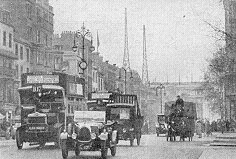In
the late 1880's the firm G.
Binswanger & Co. was founded by the brothers Gustav and Max
Binswanger together with their colleague Hugo Hirst. Later on
the name was changed to General Electric Apparatus Company. The
company started producing telephones and electric bells in a
factory in Manchester. In 1889 the name was changed again to
General Electric Company Limited; headquarters were moved to London. In 1893
production of electric light bulbs started. In 1913, GEC
commissioned the building of a new headquarters in London: Magnet House.
Because of the First World War, the building was not finished
until 1921. During the war GEC made "R" valves carrying the
trade mark Osram. In 1919 a new company was formed, together
with Marconi:
Marconi-Osram Valve Co.
In the beginning of the 1920s,
GEC was ready for the start of the radio era in Great Britain.
The company produced radios, loudspeakers, headphones and
amplifiers for a wide range of customers.
On October 18, 1922, the British Broadcasting Company (BBC) was
set up by a consortium of radio receiver manufacturers (Western
Electric, Marconi, General Electric, British Thomson-Houston,
Radio Communication and Metropolitan Vickers) for regular
broadcasting of programmes of speech and music, but the spread of broadcasting was
more or less held back by the need
to obtain a receiving licence from the Postmaster-General.
 |
|
2LO aerials on the roof of Selfridges
in Oxford Street, London. |
On November 1 1922, the first ten-shilling (18 Euro in today's money)
broadcasting receiving licence was introduced. Two weeks later,
on Tuesday 14th,
its first daily programmes from London (station 2LO) started
from Marconi House. On January 18, 1923, the BBC was granted its formal licence to
broadcast.
Stations were also opened in Birmingham (5IT), Manchester
(2ZY), and Newcastle-upon-Tyne (5NO).
In the first year,
2LO,
transmitting in the medium wave band, reached an
audience of about 18,000 listeners.
By October 1923 all of the
stations were in operation, and reached about half of the
population, with signals that were strong enough to be received
by a crystal set.
2LO’s duties were
assumed by a new transmitter located at Selfridge’s, Oxford
Street, in 1925.
 |
| Early BBC Radio stamps |
| Left: BBC/PMG, used
form November 1st, 1922 to September 1924. Centre: BBC/EBM,
used from September 1924 to 1927. Right: BBC trademark,
used from September 1924 to 1927. On January 1st, 1925
stamp regulations were abolished and firms were no
longer obliged to use any BBC stamps. |
|